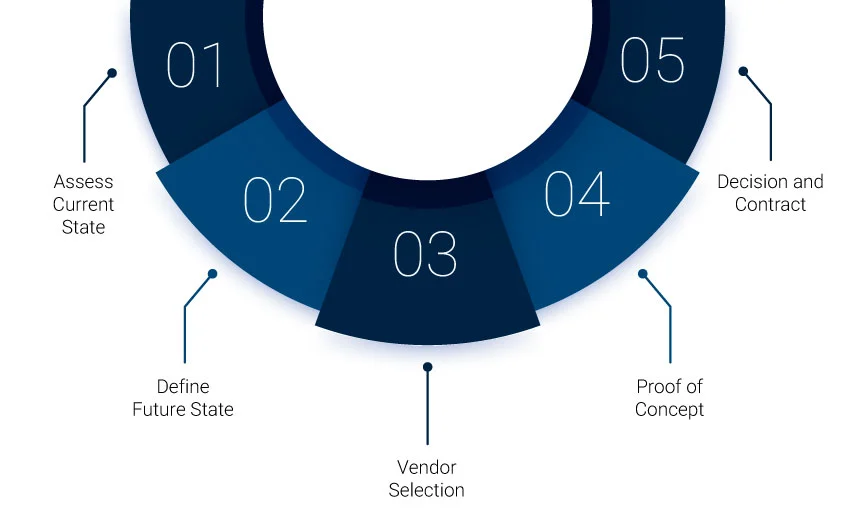November 4, 2024 - by Will Payman
The marketing technology (MarTech) ecosystem is in a constant state of flux, with new tools emerging and existing platforms evolving rapidly. Organizations face the daunting challenge of selecting solutions that not only meet current needs but can also scale for future requirements—all while navigating an overwhelming array of options.

The pressure isn’t just about adopting technology; it’s about making strategic choices that align with existing systems, considering team capabilities and skill sets, and building an integrated MarTech stack that can effectively support evolving business objectives. As customer expectations continue to rise, businesses must stay competitive while anticipating future market demands through their technology investments.
Given these complex market dynamics, how do you build a MarTech stack that not only meets your current needs but also supports your future growth? Let’s dive into the process of selecting your MarTech stack and explore the key considerations to keep in mind.
The Importance of a Thorough Selection Process
When considering a MarTech stack, you’re making a decision that will impact your organization for the next two to three years, possibly longer. It’s crucial to go through a rigorous process rather than simply listing desired features and jumping to implementation.
Here are the key steps to follow:
- Assess Current State: Evaluate your existing tools, processes, and capabilities. This provides a clear starting point and helps identify gaps in your current setup.
- Define Future State: Outline your desired marketing capabilities and goals. Consider using customer journey maps or service blueprints to envision the experience you want to deliver in the coming years. You may even want to storyboard the experience.
- Vendor Selection: Research and shortlist potential MarTech providers that align with your future vision.
- Proof of Concept: Test selected tools in a controlled environment. Most vendors will create a proof of concept if you provide them with a scenario and data.
- Decision and Contract – Make your decision on your platform, and finalize your contract and payment terms. This includes the final set of platform capabilities, including add-ons like hosting and support levels, terms of contract, and payment arrangements.

By following these steps, you’ll create a comprehensive approach to selecting and implementing your MarTech stack. This thorough process helps ensure that your chosen tools meet your current needs, support your future growth, and adapt to changing market conditions.
Three Common MarTech Stack Approaches
There are three main solution types we see with our clients. The “best of breed” approach offers one or two targeted solutions to fill specific capability gaps. This option is often budget-friendly in terms of both cost and implementation.
The “DXP” approach is ideal for organizations with weak existing capabilities and broad future needs. This approach can be attractive due to its comprehensive modernization, ease of training, and pricing.
Finally, the “enterprise enhancement” approach is suitable for companies with significant investments in a single enterprise solution provider. These MarTech solutions typically work well together, and pricing can be favorable due to the organization’s overall investment. Let’s look at the pros and cons of each approach.
1. Best of Breed
This approach involves selecting individual tools that excel in specific capabilities. Examples include WordPress for content management, HubSpot for marketing automation, Shopify for e-commerce, etc.
Pros:
- Access to best-in-class tools for each function
- Flexibility to invest in the most critical capabilities
Cons:
- Complex integrations
- Multiple licenses and upgrades to manage
- Potential training challenges due to diverse interfaces
2. Digital Experience Platforms (DXP)
These comprehensive solutions offer a broad set of capabilities across content, marketing, commerce, and analytics. Examples include Adobe Experience Manager, Sitecore, and Kentico.
Pros:
- Single license and unified interface
- Fewer integration challenges
- Consistent user experience across tools
Cons:
- Capabilities may range from best-in-class to merely adequate
- Potential over-investment in unused features
3. Enterprise Platforms
This approach involves adding marketing capabilities to existing enterprise platforms, such as procurement, sales, and inventory management systems, from solution providers like Microsoft, Salesforce, Oracle, etc.
Pros:
- Leverage existing investment in enterprise platforms
- Strong marketing automation capabilities
- Seamless integration with sales and service data
Cons:
- May require the use of the associated CRM for optimal performance
- Potentially weaker content management capabilities
It’s worth noting that some organizations adopt a hybrid approach, using a DXP for most capabilities but adding best-of-breed solutions for critical functions where the DXP falls short.
A Strategic Approach to MarTech Success
Selecting and implementing the right MarTech stack is a complex journey that’s difficult to navigate alone. Just as a realtor’s expertise is invaluable when purchasing a house, having an experienced technology partner can be the difference between success and costly missteps in your MarTech investment.
The right partner brings critical advantages: a deep understanding of business processes, the ability to align technology with cross-departmental needs, established relationships with leading vendors, and expertise in budgeting and pricing negotiations. They can also help you anticipate future roles and skills your team will need to make any technology investment successful.
This ongoing journey requires regular assessment, adaptation, and optimization. Working with a trusted partner like Synoptek ensures you have the strategic guidance and technical expertise to transform your MarTech stack into a powerful engine for marketing excellence and business growth.
Ready to create a future-ready MarTech stack? Our MarTech consultation services provide the expertise you need to make informed decisions and successful implementations. Contact our experts to begin your journey with a partner who understands your business and technology needs.
About the Author
Will Payman, a Senior Director of Strategy—CX at Synoptek, leads the digital strategy and analytics discipline for various clients across different industries. He supports clients with digital strategy activities and deliverables, including competitive analysis, opportunity assessment, current state assessments, and strategy development. Additionally, he leads the analytics team, overseeing setup, reporting, insights, and recommendations for experience improvements.

